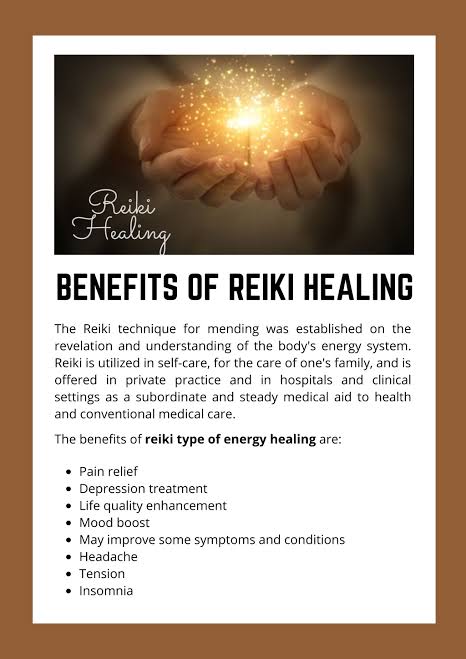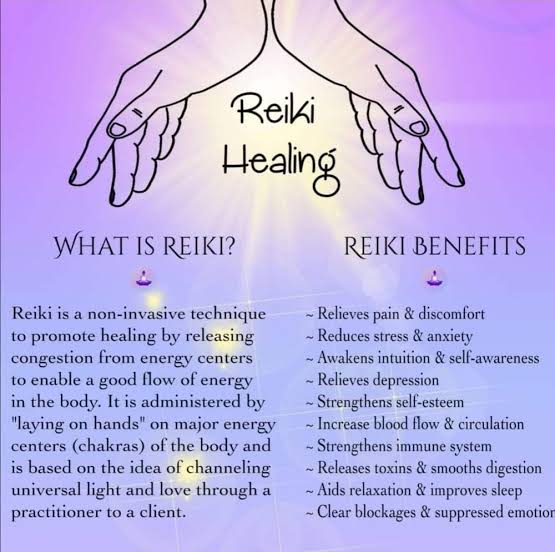Reiki is a Japanese technique for stress reduction and relaxation that also promotes healing. It is administered by "laying on hands" and is based on the idea that an unseen "life force energy" flows through us and is what causes us to be alive. If one's "life force energy" is low, then we are more likely to get sick or feel stress, and if it is high, we are more capable of being happy and healthy.
The word Reiki is made of two Japanese words - Rei which means "God's Wisdom or the Higher Power" and Ki which is "life force energy". So Reiki is actually "spiritually guided life force energy."
A treatment feels like a wonderful glowing radiance that flows through and around you. Reiki treats the whole person including body, emotions, mind and spirit creating many beneficial effects that include relaxation and feelings of peace, security and wellbeing. Many have reported miraculous results.
Reiki is a simple, natural and safe method of spiritual healing and self-improvement that everyone can use. It has been effective in helping virtually every known illness and malady and always creates a beneficial effect. It also works in conjunction with all other medical or therapeutic techniques to relieve side effects and promote recovery.
An amazingly simple technique to learn, the ability to use Reiki is not taught in the usual sense, but is transferred to the student during a Reiki class. This ability is passed on during an "attunement" given by a Reiki master and allows the student to tap into an unlimited supply of "life force energy" to improve one's health and enhance the quality of life.
Its use is not dependent on one's intellectual capacity or spiritual development and therefore is available to everyone. It has been successfully taught to thousands of people of all ages and backgrounds.
While Reiki is spiritual in nature, it is not a religion. It has no dogma, and there is nothing you must believe in order to learn and use Reiki. In fact, Reiki is not dependent on belief at all and will work whether you believe in it or not. Because Reiki comes from God, many people find that using Reiki puts them more in touch with the experience of their religion rather than having only an intellectual concept of it.
While Reiki is not a religion, it is still important to live and act in a way that promotes harmony with others. Mikao Usui, the founder of the Reiki system of natural healing, recommended that one practice certain simple ethical ideals to promote peace and harmony, which are nearly universal across all cultures.
During a meditation several years after developing Reiki, Mikao Usui decided to add the Reiki Ideals to the practice of Reiki. The Ideals came in part from the five prinicples of the Meiji emperor of Japan whom Mikao Usui admired. The Ideals were developed to add spiritual balance to Usui Reiki. Their purpose is to help people realize that healing the spirit by consciously deciding to improve oneself is a necessary part of the Reiki healing experience. In order for the Reiki healing energies to have lasting results, the client must accept responsibility for her or his healing and take an active part in it. Therefore, the Usui system of Reiki is more than the use of the Reiki energy. It must also include an active commitment to improve oneself in order for it to be a complete system. The ideals are both guidelines for living a gracious life and virtues worthy of practice for their inherent value.


Practitioners will typically give Reiki treatment in a peaceful, private setting. However, the treatment can take place anywhere. During a session, the client will sit in a comfortable chair or lie on a table, fully clothed.
The practitioner will then place their hands lightly on or over specific areas of the client’s head, limbs, and torso. They will typically keep their hands in these positions for 3–10 minutes.
If there is a particular injury, such as a burn, the practitioner will hold their hands just above the wound.
Advocates state that while the practitioner holds their hands lightly on or over the body, an energy transfer takes place. During this time, the practitioner may report that their hands feel warm or are tingling. They will hold each hand position until they sense that the energy has stopped flowing.
When the practitioner feels that the heat, or energy, in their hands has gone, they will remove their hands and place them over a different body area.

No prior training, education, or experience is necessary to enter the Reiki training or “attunement process.”
In this process, the Reiki master reportedly transfers the attunement energy and healing techniques to the student.
Reiki training varies, but most students learn about:
The energies around the body
How to work with healing energy
The ethics of working with clients

Preparation for attunement may include avoiding alcohol and caffeine for 1–3 days, meditation, focusing on nature, and releasing negative emotions.
There are three levels of mastery. Those who reach “Master” level can teach others and can reportedly heal from a distance.